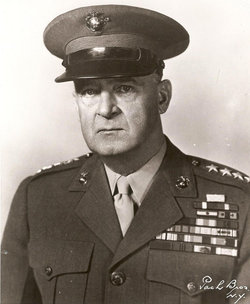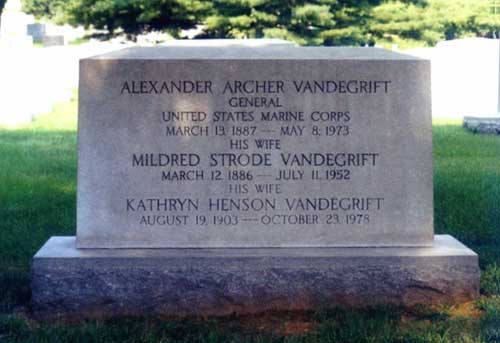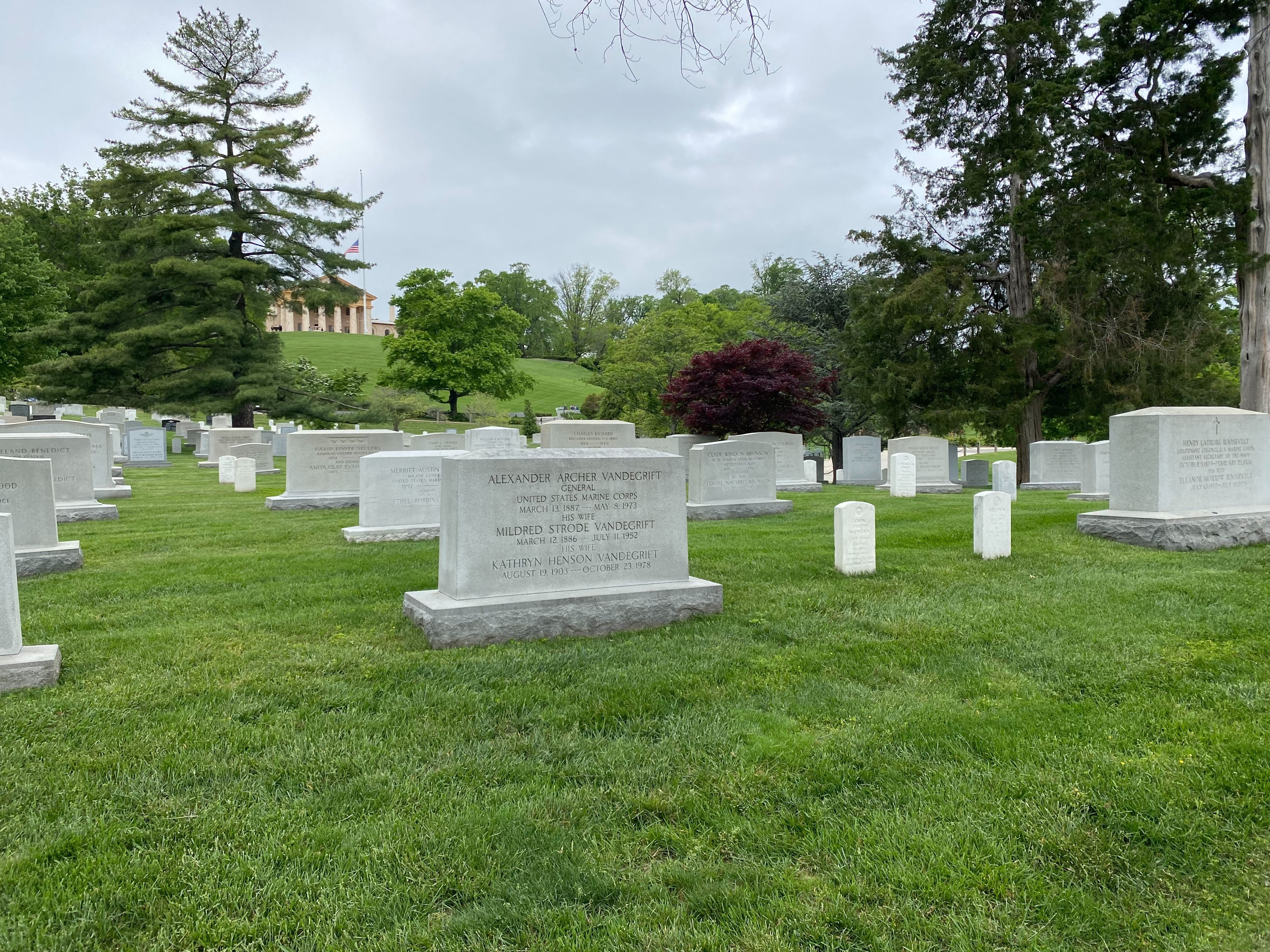Medal of Honor Recipient. He was the first U.S. Marine to hold the rank of four-star general while on active duty and served as the 18th Commandant of the Marine Corps. During World War II (WWII), he commanded the 1st Marine Division to victory in its first ground offensive of the war, at the Battle of Guadalcanal. Born Alexander Archer Vandegrift, his father was an architect and a contractor, and he developed his interest in the military from reading military history novels and listening to stories of ancestors who had fought in previous wars. He attended the University of Virginia at Charlottesville, Virginia for three years before receiving his commission in the U.S. Marine Corps through a week-long competitive examination in 1908, and became a 2nd lieutenant in January 1909. In 1910, following instruction at the Marine Officers' School in Port Royal, South Carolina, he was assigned to the Marine Corps Barracks, Navy Yard, Portsmouth, New Hampshire. In 1912, he was sent to foreign shore duty in the Caribbean Sea, first to Cuba and then to Nicaragua, where he participated in the bombardment, assault, and capture of Coyotepe in Nicaragua, followed in 1914 with his participation in the engagement and occupation of Vera Cruz, Mexico. In December 1914, following his promotion to the rank of first lieutenant, he attended the Advance Base Course at the Marine Barracks in Philadelphia, Pennsylvania and after its completion, he returned to the Caribbean with the 1st Marines and participated in action against hostile Cacos bandits at Le Trou and Fort Capois, Haiti. In August 1916, he was promoted to the rank of captain and became a member of the Haitian Constabulary at Port-au-Prince, where he remained until detached to the U.S. in December 1918. He returned to Haiti again in July 1919 to serve with the Gendarmerie d'Haiti as an Inspector of Constabulary. In June 1920, he was promoted to the rank of major. In April 1923, he returned to the U.S. and was assigned to the Marine Barracks, MCB Quantico, Virginia. He completed the Field Officers' Course, Marine Corps Schools in May 1926 and was then transferred to the Marine Corps Base San Diego, California as Assistant Chief of Staff. In February 1927, he was sent to China where he served as Operations and Training Officer of the 3rd Marines with Headquarters at Tientsin (now Tianjin). In September 1928, he returned to the U.S. and became Assistant Chief Coordinator, Bureau of the Budget, in Washington, D.C. He returned to the Marine Barracks, Quantico, where he became Assistant Chief of Staff, G-1 Section, Fleet Marine Force and was promoted to the rank of lieutenant colonel in June 1934. He returned to China in June 1935 and served as the executive officer and commanding officer of the Marine Detachment at the American Embassy in Peiping (now Beijing). In September 1936, he was promoted to the rank of colonel and returned to the US in June 1937 to become the Military Secretary to the Major General Commandant, Headquarters Marine Corps, Washington, D.C. In March 1940, he was appointed Assistant to the Major General Commandant, and the following month was promoted to the rank of brigadier general. In November 1941, he was ordered to the 1st Marine Division in California, shortly before the Japanese attack on Pearl Harbor, ushering the US entry into World War II. He was promoted to the rank of major general in March 1942 and sailed for the South Pacific Area two months later as commanding general of the first Marine division to ever leave the shores of the US. On August 7, 1942, in the Solomon Islands, he led the 1st Marine Division in the first large-scale offensive action against the Japanese. For outstanding service as Commanding General of the 1st Marine Division during the attack on Guadalcanal, Tulagi, and Gavutu in the Solomon Islands, he was awarded the Navy Cross and for the subsequent occupation and defense from August 7 to December 9, 1942, he was awarded the Medal of Honor. In July 1943, he assumed command of the 1st Marine Amphibious Corps and commanded this organization in the landing at Empress Augusta Bay, Bougainville, Northern Solomon Islands, on November 1, 1943. Upon establishing the initial beachhead, he relinquished command and returned to Washington, D.C. as Commandant-designate. In January 1944, at the rank of lieutenant general, he was sworn in as the 18th Commandant of the Marine Corps. In April 1945, he was promoted to the rank of general, the first Marine officer on active duty to attain four-star rank. He left active service on December 31, 1947 and was placed on the retired list on April 1, 1949, with 40 years of military service. Other than the Medal of Honor and the Navy Cross, his U.S. and foreign military decorations and awards include the Navy Distinguished Service Medal, the Navy Presidential Unit Citation with one star, the Navy Unit Commendation with one star, the Marine Corps Expeditionary Medal with three stars, the Nicaraguan Campaign Medal, the Mexican Service Medal, the Haitian Campaign Medal with one star, the World War I Victory Medal with West Indies clasp & one star, the Yangtze Service Medal, the American Defense Service Medal, the American Campaign Medal, the Asiatic-Pacific Campaign Medal with four stars. The World War II Victory Medal, the Haitian Distinguished Service Medal, the Haitian Medaille militaire with 1 silver star, the Companion of the Order of the Bath (United Kingdom - Honorary), the Knight Commander of the Order of the British Empire (United Kingdom - Honorary), the Peruvian Cruz de Aviación de Primera Clase, the Ecuadorian Order of Abdon Calderon, 1st Class, the Netherlands Knights Grand Cross in the Order of Orange-Nassau with swords, the Chinese Order of Pao Ting (Precious Tripod) with Special Cravat, and the French Grand Officer of the Legion of Honor. He co-authored a book chronicling his experiences in World War II, "The Memoirs of General A. A. Vandegrift Commandant of the U.S. Marines in WW II." He received an honorary degree of Doctor of Military Science from Pennsylvania Military College (now Widener University) in Chester, Pennsylvania, and honorary degrees of Doctor of Law from Harvard, Colgate, Brown, Columbia, and Maryland Universities and John Marshall College. He died at the age of 86. In 1982, the Navy frigate USS Vandegrift was named in his honor. He was portrayed in the 1960 film "The Gallant Hours" by actor Raymond Bailey, the 2006 film "Flags of Our Fathers" by actor Chris Bauer, and the 2010 HBO television miniseries "The Pacific" by actor Stephen Leeder. His Medal of Honor citation reads "For outstanding and heroic accomplishment above and beyond the call of duty as commanding officer of the 1st Marine Division in operations against enemy Japanese forces in the Solomon Islands during the period 7 August to 9 December 1942. With the adverse factors of weather, terrain, and disease making his task a difficult and hazardous undertaking, and with his command eventually including sea, land, and air forces of Army, Navy, and Marine Corps, Maj. Gen. Vandegrift achieved marked success in commanding the initial landings of the U.S. forces in the Solomon Islands and in their subsequent occupation. His tenacity, courage, and resourcefulness prevailed against a strong, determined, and experienced enemy, and the gallant fighting spirit of the men under his inspiring leadership enabled them to withstand aerial, land, and sea bombardment, to surmount all obstacles, and leave a disorganized and ravaged enemy. This dangerous but vital mission, accomplished at the constant risk of his life, resulted in securing a valuable base for further operations of our forces against the enemy, and its successful completion reflects great credit upon Maj. Gen. Vandegrift, his command, and the U.S. Naval Service."
Medal of Honor Recipient. He was the first U.S. Marine to hold the rank of four-star general while on active duty and served as the 18th Commandant of the Marine Corps. During World War II (WWII), he commanded the 1st Marine Division to victory in its first ground offensive of the war, at the Battle of Guadalcanal. Born Alexander Archer Vandegrift, his father was an architect and a contractor, and he developed his interest in the military from reading military history novels and listening to stories of ancestors who had fought in previous wars. He attended the University of Virginia at Charlottesville, Virginia for three years before receiving his commission in the U.S. Marine Corps through a week-long competitive examination in 1908, and became a 2nd lieutenant in January 1909. In 1910, following instruction at the Marine Officers' School in Port Royal, South Carolina, he was assigned to the Marine Corps Barracks, Navy Yard, Portsmouth, New Hampshire. In 1912, he was sent to foreign shore duty in the Caribbean Sea, first to Cuba and then to Nicaragua, where he participated in the bombardment, assault, and capture of Coyotepe in Nicaragua, followed in 1914 with his participation in the engagement and occupation of Vera Cruz, Mexico. In December 1914, following his promotion to the rank of first lieutenant, he attended the Advance Base Course at the Marine Barracks in Philadelphia, Pennsylvania and after its completion, he returned to the Caribbean with the 1st Marines and participated in action against hostile Cacos bandits at Le Trou and Fort Capois, Haiti. In August 1916, he was promoted to the rank of captain and became a member of the Haitian Constabulary at Port-au-Prince, where he remained until detached to the U.S. in December 1918. He returned to Haiti again in July 1919 to serve with the Gendarmerie d'Haiti as an Inspector of Constabulary. In June 1920, he was promoted to the rank of major. In April 1923, he returned to the U.S. and was assigned to the Marine Barracks, MCB Quantico, Virginia. He completed the Field Officers' Course, Marine Corps Schools in May 1926 and was then transferred to the Marine Corps Base San Diego, California as Assistant Chief of Staff. In February 1927, he was sent to China where he served as Operations and Training Officer of the 3rd Marines with Headquarters at Tientsin (now Tianjin). In September 1928, he returned to the U.S. and became Assistant Chief Coordinator, Bureau of the Budget, in Washington, D.C. He returned to the Marine Barracks, Quantico, where he became Assistant Chief of Staff, G-1 Section, Fleet Marine Force and was promoted to the rank of lieutenant colonel in June 1934. He returned to China in June 1935 and served as the executive officer and commanding officer of the Marine Detachment at the American Embassy in Peiping (now Beijing). In September 1936, he was promoted to the rank of colonel and returned to the US in June 1937 to become the Military Secretary to the Major General Commandant, Headquarters Marine Corps, Washington, D.C. In March 1940, he was appointed Assistant to the Major General Commandant, and the following month was promoted to the rank of brigadier general. In November 1941, he was ordered to the 1st Marine Division in California, shortly before the Japanese attack on Pearl Harbor, ushering the US entry into World War II. He was promoted to the rank of major general in March 1942 and sailed for the South Pacific Area two months later as commanding general of the first Marine division to ever leave the shores of the US. On August 7, 1942, in the Solomon Islands, he led the 1st Marine Division in the first large-scale offensive action against the Japanese. For outstanding service as Commanding General of the 1st Marine Division during the attack on Guadalcanal, Tulagi, and Gavutu in the Solomon Islands, he was awarded the Navy Cross and for the subsequent occupation and defense from August 7 to December 9, 1942, he was awarded the Medal of Honor. In July 1943, he assumed command of the 1st Marine Amphibious Corps and commanded this organization in the landing at Empress Augusta Bay, Bougainville, Northern Solomon Islands, on November 1, 1943. Upon establishing the initial beachhead, he relinquished command and returned to Washington, D.C. as Commandant-designate. In January 1944, at the rank of lieutenant general, he was sworn in as the 18th Commandant of the Marine Corps. In April 1945, he was promoted to the rank of general, the first Marine officer on active duty to attain four-star rank. He left active service on December 31, 1947 and was placed on the retired list on April 1, 1949, with 40 years of military service. Other than the Medal of Honor and the Navy Cross, his U.S. and foreign military decorations and awards include the Navy Distinguished Service Medal, the Navy Presidential Unit Citation with one star, the Navy Unit Commendation with one star, the Marine Corps Expeditionary Medal with three stars, the Nicaraguan Campaign Medal, the Mexican Service Medal, the Haitian Campaign Medal with one star, the World War I Victory Medal with West Indies clasp & one star, the Yangtze Service Medal, the American Defense Service Medal, the American Campaign Medal, the Asiatic-Pacific Campaign Medal with four stars. The World War II Victory Medal, the Haitian Distinguished Service Medal, the Haitian Medaille militaire with 1 silver star, the Companion of the Order of the Bath (United Kingdom - Honorary), the Knight Commander of the Order of the British Empire (United Kingdom - Honorary), the Peruvian Cruz de Aviación de Primera Clase, the Ecuadorian Order of Abdon Calderon, 1st Class, the Netherlands Knights Grand Cross in the Order of Orange-Nassau with swords, the Chinese Order of Pao Ting (Precious Tripod) with Special Cravat, and the French Grand Officer of the Legion of Honor. He co-authored a book chronicling his experiences in World War II, "The Memoirs of General A. A. Vandegrift Commandant of the U.S. Marines in WW II." He received an honorary degree of Doctor of Military Science from Pennsylvania Military College (now Widener University) in Chester, Pennsylvania, and honorary degrees of Doctor of Law from Harvard, Colgate, Brown, Columbia, and Maryland Universities and John Marshall College. He died at the age of 86. In 1982, the Navy frigate USS Vandegrift was named in his honor. He was portrayed in the 1960 film "The Gallant Hours" by actor Raymond Bailey, the 2006 film "Flags of Our Fathers" by actor Chris Bauer, and the 2010 HBO television miniseries "The Pacific" by actor Stephen Leeder. His Medal of Honor citation reads "For outstanding and heroic accomplishment above and beyond the call of duty as commanding officer of the 1st Marine Division in operations against enemy Japanese forces in the Solomon Islands during the period 7 August to 9 December 1942. With the adverse factors of weather, terrain, and disease making his task a difficult and hazardous undertaking, and with his command eventually including sea, land, and air forces of Army, Navy, and Marine Corps, Maj. Gen. Vandegrift achieved marked success in commanding the initial landings of the U.S. forces in the Solomon Islands and in their subsequent occupation. His tenacity, courage, and resourcefulness prevailed against a strong, determined, and experienced enemy, and the gallant fighting spirit of the men under his inspiring leadership enabled them to withstand aerial, land, and sea bombardment, to surmount all obstacles, and leave a disorganized and ravaged enemy. This dangerous but vital mission, accomplished at the constant risk of his life, resulted in securing a valuable base for further operations of our forces against the enemy, and its successful completion reflects great credit upon Maj. Gen. Vandegrift, his command, and the U.S. Naval Service."
Bio by: William Bjornstad
Inscription
GENERAL
UNITED STATES MARINE CORPS
Family Members
Advertisement
See more Vandegrift memorials in:
Advertisement











